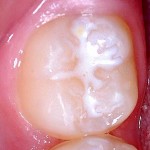
Fissure sealants have been available since the 1960s. There is good evidence to support their effectiveness and a number of evidence-based guidelines recommend them to prevent and control dental caries. Retention of sealant is considered to be an important element of their effectiveness.
The aim of this review was to assess the clinical effects of laser preparation compared to other types of chemical or mechanical preparation of tooth surfaces used in fissure sealant placement.
Methods
Searches were conducted in the PubMed/Medline, Embase, Scopus, Cochrane Library, OpenGrey, ClinicalTrials.gov and the International Standard Randomised Controlled Trial Number (ISRCTN) registry databases. Randomised controlled trials (RCTs) using laser and other pre-treatment methods before fissure sealant application published in English were considered. Two reviewers selected studies and independently abstracted data and assessed risk of bias using the Cochrane tool and meta-analysis was carried out where possible.
Results
- 5 RCTs (3 split-mouth, 2 parallel design) involving a total of 201 patients were included.
- Follow-up periods ranged from 12-36 months.
- All 5 studies compared lasers with acid etching.
- 2 studies used erbium, chromium: yttrium-scandium-gallium-garnet (Er, Cr: YSGG) lasers, 2 Er,YAG and 1 carbon dioxide lasers.
- All 5 studies were considered to be at high risk of bias.
- Retention rates ranged from 35.9 to 97.92% in the laser only group, 77.4% in the laser combined with acid etching group and 41.0 to 94.59% in the acid-etching only group
- 3 RCTs contributed to a meta-analysis of retention rates
| Follow-up | Odds Ratio | 95% Confidence Interval |
| 3 months | 2.78 | 0.87–8.91 |
| 6 months | 1.22 | 0.69–2.16 |
| 12 months | 1.05 | 0.61–1.80 |
- 2 studies reported on caries incidence with no statistically significance being reported between laser and acid-etch groups.
- 1 study reported shorter clinical time was required for the laser procedure.
- No adverse effects were reported.
Conclusions
The authors concluded: –
….laser preparation was a safe, effective and highly-acceptable method of enamel preparation before sealant placement. The retention rate of pit-and- fissure sealants after laser preparation alone was comparable to that of acid-etching preparation. Furthermore, laser preparation used as a supplementary method to conventional acid-etching enhanced the retention rate of sealants. However, the current study exhibited an overall high risk of bias. Further research with a better study de- sign is required to provide more reliable evidence for clinical application.
Comments
While a good range of databases have been searched for this review restricting inclusions to English language paper could have included some relevant studies. All the included studies are small and at high risk of bias. This was mainly due to lack of blinding of patients and personnel although outcome assessors where blinded in all the studies. All the included studies were unclear on allocation concealment and all but one study was unclear on the random sequence generation. So while this review suggests that sealant retention with laser preparation is similar to acid-etching the fact that there are only a small number of small studies at high risk of bias means that the findings should be viewed very cautiously.
Links
Primary Paper
Zhang Y, Wang Y, Chen Y, Chen Y, Zhang Q, Zou J. The clinical effects of laser preparation of tooth surfaces for fissure sealants placement: a systematic review and meta-analysis. BMC Oral Health. 2019 Sep 2;19(1):203. doi:10.1186/s12903-019-0892-4. PubMed PMID: 31477081; PubMed Central PMCID: PMC6719354.
Other references
Dental Elf – 8th Apr 2013
Review recommends fissure sealants for caries prevention in permanent teeth
Dental Elf – Fissure Sealant Blogs
